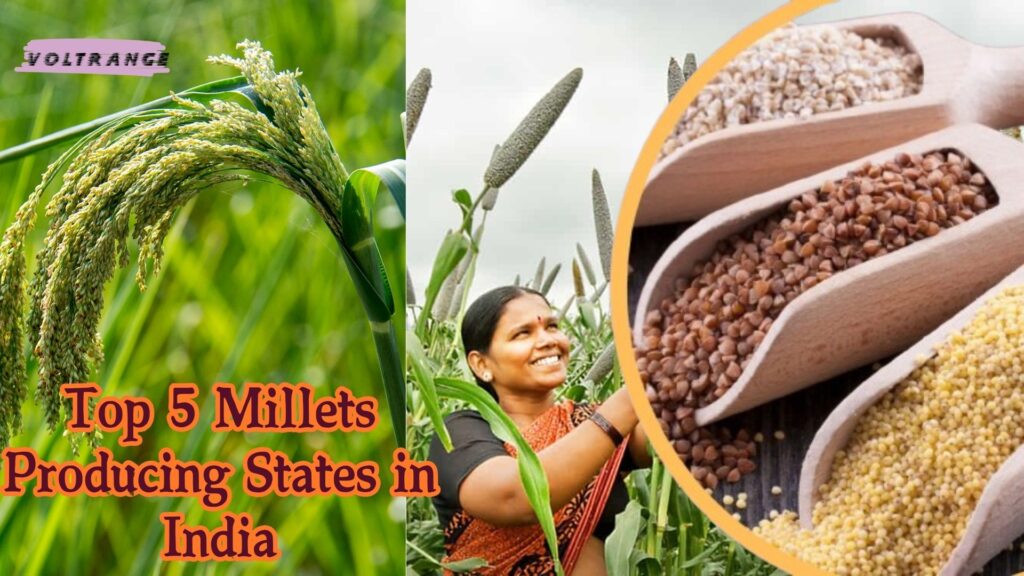
Top 5 Millets Producing States in India
Millets Producing States in India: Millets, a staple grain across Asia and Africa, play a crucial role in feeding over 1.2 billion people globally. Known for their resilience and high nutritional value, millets are an essential crop, particularly in developing nations where food security is critical. India stands as the largest consumer and producer of millets, contributing 30.9 million tonnes to global production. As millets gain popularity for their adaptability to challenging climates and increasing governmental support, their significance in Indian agriculture continues to grow.
In this article, we’ll dive into the top five millet-producing states in India. These regions not only cater to the local demand but also contribute significantly to international markets. Let’s explore how each state contributes to India’s millet revolution and what makes them stand out in millet cultivation.
1. Rajasthan: The Millet Powerhouse of India
Rajasthan leads India’s millet production, accounting for a massive 27% of the nation’s total output. Despite its arid climate, the state’s farmers have mastered the art of millet cultivation, particularly focusing on Bajra and Pearl Millet. From the vast fields of the Thar Desert to the fertile plains of Mewar, Rajasthan’s commitment to millet is unmatched. The state’s adaptability in growing millets under harsh climatic conditions has earned it the title of “Millet Master of India.” Millets Producing States in India
Farmers in Rajasthan understand that millets are not just resilient but also nutrient-packed, making them a vital crop for food security in this water-scarce region. With the government providing incentives to support millet farmers, the state continues to hold its position as the top millet producer in India.
2. Karnataka: A Rising Star in Millet Production
Karnataka takes the second spot, contributing 18% to India’s millet production. The state has even branded its millets under the name Siridhanya, showcasing a variety of millets like Ragi (finger millet), Navane (foxtail millet), Same (little millet), and Haruka (kodo millet). These millets are an integral part of Karnataka’s cuisine, particularly in regions like Koppal, Raichur, and Bellary. Millets Producing States in India
The state government has implemented several programs to promote millet farming, offering farmers both financial and technical assistance. The popularity of millets in local dishes and their increasing demand in health-conscious markets further solidify Karnataka’s role as a major player in India’s millet production landscape.
3. Maharashtra: A Hub for Diverse Millet Varieties
Maharashtra ranks third, contributing 14% to India’s overall millet production. The state grows various millet varieties, including Nachani (finger millet) and Bajra (pearl millet), which are staples in the local cuisine. Popular dishes like Bhakri, made from millet flour, highlight the crop’s cultural and culinary importance in the state.
Regions like Sangli, Yavatmal, and Jalgaon are known for their high millet output. The Rashtriya Krishi Vikas Yojana (RKVY) initiative provides financial support to millet farmers, helping improve yields and sustain the crop’s growth under challenging conditions. Millets thrive in Maharashtra’s dry and rain-fed areas, making them an essential crop for the state’s food security and rural economy. Millets Producing States in India
4. Uttar Pradesh: Bridging Traditional Farming and Modern Demand
Uttar Pradesh, contributing 12% to India’s millet production, is a significant player in the millet market. While the state is more commonly associated with rice and wheat, millets are increasingly being cultivated due to their ability to withstand poor soil and climatic conditions. Pearl millet and Sorghum are particularly popular in the region, serving both as a food crop and as fodder for livestock. Millets Producing States in India
The state government is actively promoting millet farming, recognizing its potential to improve food security and nutritional intake. The ability of millets to grow in low-moisture conditions makes them an ideal crop for regions with unpredictable rainfall, further boosting their appeal in Uttar Pradesh.
5. Madhya Pradesh: Nurturing Millet in the Heart of India
Madhya Pradesh contributes 6% to India’s overall millet production. Despite its smaller share, the state has shown a steady commitment to growing millets, particularly in regions like Dindori, Mandla, Umaria, and Betul. With adequate rainfall and a favorable climate, Madhya Pradesh has the potential to expand its millet production significantly.
Local communities in the state consume millet as part of their daily diet, recognizing its health benefits. As the government continues to support millet cultivation through various schemes, Madhya Pradesh is poised to play a more prominent role in India’s millet-producing landscape in the coming years. Millets Producing States in India
India’s Millet Revolution: A Path Toward Sustainability
The resurgence of millet farming in India is driven not only by its nutritional benefits but also by its ability to withstand harsh climates and thrive in low-fertility soils. With increasing awareness of sustainable farming practices and health-conscious consumers seeking alternatives to wheat and rice, millets are making a strong comeback. Millets Producing States in India
Government initiatives, such as the National Year of Millets and financial incentives for millet farmers, are also boosting production and encouraging more farmers to adopt millet cultivation. As India continues to lead global millet production, the country is well-positioned to meet both domestic and international demand for this ancient grain.
FAQs about Millets Producing States in India
What are the main types of millets grown in India?
India cultivates a variety of millets, including Bajra (pearl millet), Ragi (finger millet), Jowar (sorghum), Navane (foxtail millet), and Haruka (kodo millet). Each region grows different types based on the local climate and soil conditions.
Why is millet gaining popularity in India?
Millets are gaining popularity due to their resilience to harsh climates, low water requirements, and high nutritional value. Government incentives and growing health awareness have also contributed to their resurgence in Indian agriculture.
Which state is the largest producer of millet in India?
Rajasthan is the largest producer of millet in India, contributing 27% of the country’s total millet production. The state is known for cultivating Bajra and Pearl Millet despite its arid climate.
How do government initiatives support millet farming in India?
The Indian government has launched several initiatives, such as subsidies, technical support, and awareness campaigns like the National Year of Millets. These programs aim to boost millet production, provide financial aid to farmers, and promote the health benefits of millets.
What are the health benefits of consuming millets?
Millets are rich in essential nutrients like fiber, protein, vitamins, and minerals. They are also gluten-free, making them an excellent option for people with gluten sensitivities. Regular consumption of millets can help manage weight, control blood sugar, and improve digestive health.





More Stories
which of the following statements is true about education and lifetime earnings? Complete Guide Here
Statekaidz.com: Education with Fun For Kids 2025
Top 5 Richest States in India by GDP